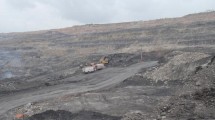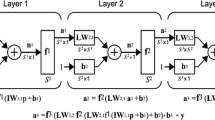Abstract
The growth of density and circulation speed of railway transportation systems in urban areas increases the importance of the research issues of the produced environmental impacts. This study presents a field data analysis, obtained during monitoring campaigns of ground vibration, due to light railway traffic in urban areas, based on the artificial neural network (ANN) approach, using quantitative and qualitative predictors. Different ANN-based models, using those predictors, were evaluated/trained and validated. Using several criteria, including those that measures the possibility of ANN overfitting (RR2) and complexity (AIC), the best ANN model was successfully obtained for Lisbon area. This model, with 16 input elements (quantitative and qualitative predictors), 2 neurons on the hidden layer with a hyperbolic tangent sigmoid transfer function, and 1 neuron on the output layer considering a linear transfer function, has 0.9720 for the coefficient of determination and 0.5293 for the sum squared error.
Similar content being viewed by others
Abbreviations
- AIC:
-
Akaike information criteria
- ANOVA:
-
Analysis of variance
- ANN:
-
Artificial neural network
- FFT:
-
Fast Fourier transform
- FTA:
-
Federal Transit Administration
- FRA:
-
Federal Railroad Administration
- ISO:
-
International Organization for Standardization
- LFSS:
-
Sum of the squared lack-of-fit error
- MSE:
-
Mean squared error
- PESS:
-
Sum of the squared pure error
- SBIC:
-
Schwarz–Bayesian information criteria
- SSE:
-
Sum of the squared error
- SST:
-
Total sum of squares
- A :
-
Ground vibration peak amplitude
- B :
-
Building type (qualitative predictor)
- Cn :
-
Category of a qualitative variable
- C :
-
Coefficient of determination matrix between pairs of distinct columns of matrix X
- c :
-
Vibration propagation velocity
- E :
-
Energy
- f :
-
Wave frequency
- f(s):
-
Transfer function
- G :
-
Dominant geology (qualitative predictor)
- hls:
-
Hidden layer size
- D :
-
Distance
- Kn :
-
Indicator variables
- PVS:
-
Peak velocity sum
- Q :
-
Quality factor
- R2:
-
Coefficient of determination
- \(R_{\text{Max}}^{2}\) :
-
Maximum coefficient of determination
- RR2 :
-
Ratio of coefficients of determination
- s :
-
Input of the transfer function
- T :
-
Rail track type (qualitative predictor)
- \(\varvec{t}\left( {\varvec{\gamma}^{h} \varvec{x} +\varvec{\theta}^{h} } \right)\) :
-
Vector of transfer functions associated to two neurons of the hidden layer
- V :
-
Train circulation speed
- X :
-
Input matrix
- x :
-
Vector of the input variable
- xi :
-
Input variable
- Y :
-
Output vector
- Yi :
-
Sum of a predicted mean response
- α :
-
Damping factor
- ∆E :
-
Dissipated energy
- γ :
-
Parameter (or weight)
- \(\varvec{\gamma}^{O}\) :
-
Weights between the hidden layer and the output layer
- \(\gamma_{ij}\) :
-
Adjustable parameters
- \(\varvec{\gamma}^{h}\) :
-
Weights between the inputs and the hidden layer
- \(\theta^{O}\) :
-
Bias of the output vector
- \(\varvec{\theta}^{h}\) :
-
Bias vector for the hidden layer
- θj :
-
Bias
References
Connolly DP, Kouroussis G, Laghrouche O, Ho CL, Forde MC (2014) Benchmarking railway vibrations—track, vehicle, ground and building effects. Constr Build Mater 92:64–81. doi:10.1016/j.conbuildmat.2014.07.042
Connolly DP, Marecki GP, Kouroussis G, Thalassinakis I, Woodward P (2015) The growth of railway ground vibrations problems—a review. Sci Total Environ. doi:10.1016/j.trgeo.2015.09.002
Kouroussis G, Connolly DP, Verlinden O (2014) Railway-induced ground vibrations—a review of vehicle effects. International journal of rail transportation 2(2):69–110. doi:10.1008/23248378.2014.897791
Wilson GP, Saurenman HJ, Nelson JT (1983) Control of ground-borne noise and vibration. J Sound Vib 87(2):339–350. doi:10.1016/0022-460X(83)90573-4
Nelson JT (1996) Recent developments in ground-borne noise and vibration control. J Sound Vib 193(1):367–376. doi:10.1006/jsvi.1996.0277
Hanson CE, Towers DA, Meister LD (2005) High-speed ground transportation noise and vibration impact assessment. HMMH report 293630-4. U.S. Department of Transportation, Federal Railroad Administration, Office of Railroad Development, October
Hanson CE, Towers DA, Meister LD (2006) Transit noise and vibration impact assessment. Report FTA-VA-90-1003-06. U.S. Department of Transportation, Federal Transit Administration, Office of Planning and Environment, May
International Organization for Standardization, ISO 14837-1:2005. Mechanical vibration—ground-borne noise and vibration arising from rail systems, part 1: general guidance
Grundmann H, Lieb M, Trommer E (1999) The response of a layered half-space to traffic loads moving along its surface. Arch Appl Mech 69(1):55–67. doi:10.1007/s004190050204
Sheng X, Jones CJC, Petyt M (1999) Ground vibration generated by a load moving along a railway track. J Sound Vib 228(1):129–156. doi:10.1006/jsvi.1999.2406
Picoux B, Le Houédec D (2005) Diagnosis and prediction of vibration from railway trains. Soil Dyn Earthq Eng 25:905–921. doi:10.1016/j.soildyn.2005.07.002
Lombaert G, Degrande G, Kogut J, François S (2006) The experimental validation of a numerical model for the prediction of railway induced vibrations. J Sound Vib 297(3–5):521–535. doi:10.1016/j.jsv.2006.03.048
Lombaert G, Degrande G, Vanhauwere B, Vandeborght B, François S (2006) The control of ground-borne vibrations from railway traffic by means of continuous floating slabs. J Sound Vib 297(3–5):946–961. doi:10.1016/j.jsv.2006.05.013
Galvín P, Domínguez J (2007) Analysis of ground motion due to moving surface loads induced by high-speed trains. Eng Anal Bound Elem 31:931–941. doi:10.1016/j.enganabound.2007.03.003
Metrikine AV, Vrouwenvelder T (2000) Surface ground vibration due to a moving train in a tunnel: two-dimensional model. J Sound Vib 234(1):43–66. doi:10.1006/jsvi.1999.2853
Andersen L, Jones CJC (2006) Coupled boundary and finite element analysis of vibration from railway tunnes—a comparison of two and three-dimensional models. J Sound Vib 293(3–5):611–625. doi:10.1016/j.jsv.2005.08.044
Degrande G, Clouteau D, Othman R, Arnst M, Chebli H, Klein R, Chatterjee P, Janssens B (2006) A numerical model for ground-borne vibrations from underground railway traffic based on a periodic finite element-boundary element formulation. J Sound Vib 293(3–5):645–666. doi:10.1016/j.jsv.2005.12.023
Verbraken H, Lombaert G, Degrande G (2011) Verification of an empirical prediction method for railway induced vibrations by means of numerical simulations. J Sound Vib 330:1692–1703. doi:10.1016/j.jsv.2010.10.026
Connolly DP, Kouroussis G, Giannopoulos A, Verlinden O, Woodward PK, Forde MC (2014) Assessment of railway vibrations using an efficient scoping model. Soil Dyn Earthq Eng. 58:37–47. doi:10.1016/j.soildyn.2013.12.003
Connolly DP, Kouroussis G, Woodward PK, Giannopoulos A, Verlinden O, Forde MC (2014) Scoping prediction of re-radiated ground-borne noise and vibration near high speed rail lines with variable soils. Soil Dyn Earthq Eng 66:78–88. doi:10.1016/j.soildyn.2014.06.021
Paneiro G, Durão FO, Costa e Silva M, Falcão Neves P (2015) Prediction of ground vibration amplitudes due to urban railway traffic using quantitative and qualitative field data. Transp Res D Transp Environ 40(1):1–13. doi:10.1016/j.trd.2015.07.006
Dinis da Gama C (2013) Unifying energetic approach for the control of ground vibration. In: Kwasniewsky M, Lydzba D (eds) Rock mechanics for resources, energy and environment. CRC Press, Boca Raton, pp 727–732
Gardien W, Stuit HG (2003) Modelling of soil vibrations from railway tunnels. J Sound Vib 267(3):605–619. doi:10.1016/S0022-460X(03)00727-2
Jaeger JC, Cook N, Zimmerman RW (2007) Fundamentals of rock mechanics. Blackwell, London
Ju SH (2007) Finite element analysis of structure-borne vibration from high-speed train. Soil Dyn Earthq Eng. 27(3):259–273. doi:10.1016/j.soildyn.2006.06.006
Kutner MH, Nachtsheim CJ, Neter J, Li W (2005) Applied linear statistical models. McGraw-Hill Irwin, New York
Draper NR, Smith H (1998) Applied regression analysis. Wiley, New York
Strang G (1988) Linear algebra and its applications. Thomson, Belmont
Beale MH, Hagen MT, Demuth HB (2015) Neural network toolbox™ user’s guide. The MathWorks Inc, Natick
MacKay DJC (1991) Bayesian methods for adaptive models. Ph.D. thesis, California Institute of Technology
Luke S (2013) Essentials of metaheuristics. Lulu. http://cs.gmu.edu/∼sean/book/metaheuristics/. ISBN 978-0-557-14859-2
Thomas FE, Himmelblau DM, Lasdon LS (2001) Optimization of chemical processes. McGraw-Hill, New York
Locatelli M, Schoen F (1999) Random Linkage: a family of acceptance/rejection algorithms for global optimization. Math Prog 85:379–396. doi:10.1007/s101070050062
Rinnooy AHGK, Timmer GT (1989) Global optimization. In: Nemhauser GL et al (eds) Handbooks in OR and MS, vol 1. Elsevier, Amsterdam
Rinnooy AHGK, Timmer GT (1987) Stochastic global optimization methods, part 2: multi level methods. Math Prog 39:57–78. doi:10.1007/BF02592071
Abraham B, Ledolter J (2006) Introduction to regression modeling. Thomson, Belmont
Author information
Authors and Affiliations
Corresponding author
Rights and permissions
About this article
Cite this article
Paneiro, G., Durão, F.O., Costa e Silva, M. et al. Artificial neural network model for ground vibration amplitudes prediction due to light railway traffic in urban areas. Neural Comput & Applic 29, 1045–1057 (2018). https://doi.org/10.1007/s00521-016-2625-9
Received:
Accepted:
Published:
Issue Date:
DOI: https://doi.org/10.1007/s00521-016-2625-9














